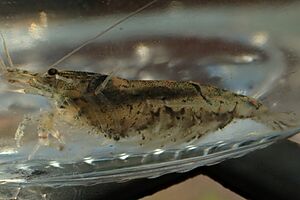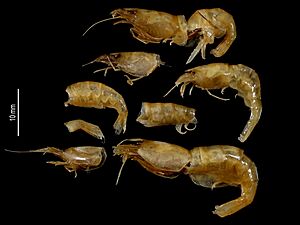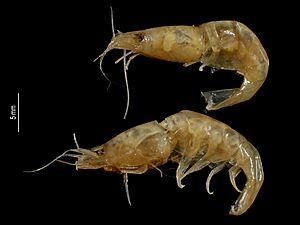Australian Amano Shrimp facts for kids
Quick facts for kids Australian Amano Shrimp |
|
|---|---|
 |
|
 |
|
| Conservation status | |
| Scientific classification | |
| Genus: |
Caridina
|
| Species: |
typus
|
The Caridina typus, also known as the Australian Amano Shrimp, is a type of shrimp. It was first described in 1837. This shrimp lives in tropical freshwater all over the Indo-West Pacific region. You can find it from eastern Africa all the way to Polynesia. It often lives in rivers and streams near the coast or on islands.
C. typus helps keep its environment healthy. It moves around sediment and breaks down dead leaves. It also plays an important role in the food chain. It eats dead things and is also food for other animals. Because of this, it's considered a keystone species. This means it's super important for the health of the stream ecosystems where it lives. Many people also keep these shrimp as pets in aquariums.
Contents
About the Australian Amano Shrimp
What They Look Like
Adult C. typus shrimp are usually about 2.0 to 2.5 centimeters long. They have two well-developed eyes on stalks, which help them see. Their rostrum, which is like a pointy extension on their head, can be different lengths. It can have between one and six small teeth.
These shrimp have five pairs of legs called pereiopods. The first two pairs have small claws that help them grab food. The third pair of legs is long and slender, also with a strong claw. The last pair of legs helps them move around. They also have five pairs of swimmerets, called pleopods, on their underside.
What They Eat
Young Caridina typus larvae eat tiny plants (phytoplankton) and tiny animals (zooplankton) that float in the water. They also eat small bits of dead material. As they grow, they can eat bigger food items. Eating a mix of different foods helps them grow faster and survive better. If they don't get enough food, they stop growing.
Older juveniles and adult shrimp mainly eat algae, dead leaves, and other decaying matter. They are known as scavengers. Their small claws help them pick up and eat small particles or even tiny insects. Like other shrimp in their family, they have special hairs on their claws. These hairs help them scrape, filter, and collect food.
How They Sense Their World
Caridina typus use their sense of smell, called chemoreception, to understand their surroundings. They can smell chemicals released by other animals. This helps them know if another animal is a predator (something that might eat them) or not. For example, they will try to avoid areas where they smell predators like crayfish or barramundi fish.
They also like the smell of other Caridina typus shrimp. This helps them find friends or potential mates, especially when it's hard to see.
Where They Live
Caridina typus are found across a huge area, from eastern Africa to Japan and Australia. They live in tropical freshwater rivers and streams. These shrimp can handle different salt levels, which helps them live near the sea. This also explains why they are found in so many places.
During the day, they often hide under rocks. At night, they come out to look for food. While they usually live in the lower parts of rivers, they can also be found higher up, even 300 meters above sea level. Their location depends on things like water speed, how much food is available, and if predators are nearby.
Life Cycle and Reproduction
Caridina typus are amphidromous. This means they travel between freshwater and saltwater during their lives, but not just for breeding. Adults live and reproduce in freshwater. However, their tiny larvae need salty water to grow. Their breeding season usually lasts from March to December.
Eggs
Female shrimp can carry many small, oval-shaped eggs. On average, they carry over 3,000 eggs, and sometimes even up to 3,700! The number of eggs a female carries depends on her size. Smaller females carry fewer eggs.
Larvae
After hatching, C. typus go through several larval stages. These larvae float freely in the water. Female shrimp travel downstream, towards the mouth of a river or into slightly salty water, to lay their eggs. The larvae then develop in this brackish (slightly salty) water. The first few larval stages need a certain level of saltiness to grow well.
Caridina typus larvae go through nine different stages before they become juveniles. This is more stages than many other Caridina shrimp.
Juveniles and Adults
Once the larval stages are complete, the shrimp change into juveniles. These young shrimp then start to travel back upstream to the freshwater habitats where their parents live. As they grow, they become adults in the freshwater.
Males and females mate in freshwater. After mating, the females will travel downstream again to lay their eggs in the slightly salty water near the river mouth.
Conservation Status
Good news! According to the IUCN Red List, which tracks how endangered species are, C. typus is considered a "least concern" species. This means it's one of the most common freshwater shrimp species and doesn't have any major threats right now.
Relationships with Other Organisms
Other Animals
- Holtodrilus truncatus: This is a tiny worm-like animal that sometimes lives on C. typus shrimp. It can be found inside or outside the shrimp's body.
- Other Shrimp Species: Caridina typus often live in the same rivers as other types of shrimp, like Macrobrachium japonicum and Macrobrachium lar. Even though they have similar life cycles and live in the same places, they don't seem to compete for food or space. They can all live together without problems.
Humans
Humans can affect C. typus in several ways:
- Dams and Floodgates: Structures like dams and floodgates can change how rivers flow. C. typus prefer rivers with smaller flows, so they might be less common in rivers with floodgates. These structures can also block their migration paths.
- Food Source: In the past, people on Pohnpei island used to eat shrimp like C. typus. Today, they are not as important for food.
- Pets: Many people keep Caridina typus as pets in aquariums. They are often called "Australian Amano Shrimp" in the pet trade, even though they live in many other places too.
Images for kids







